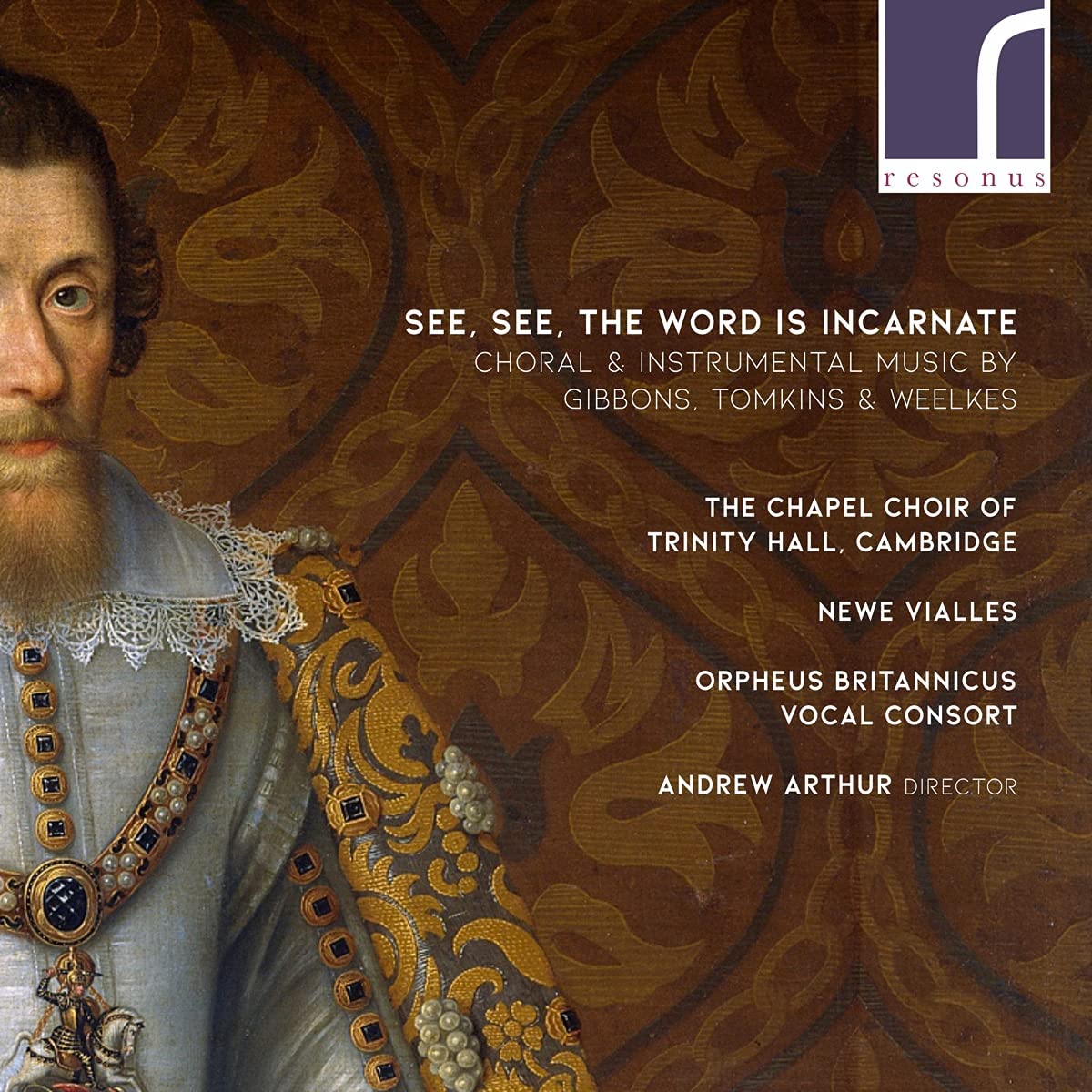Choral and instrumental music by Gibbons, Tomkins and Weelkes
The Chapel of Trinity Hall, Cambridge, Newe Vialles, Orpheus Britannicus Vocal Consort, Andrew Arthur
70:51
resonus RES10295
Click HERE to buy this album on amazon
[Doing so supports the artists, the record company and keeps this site available – if no-one buys, no money is made and the site will disappear…]
Despite a long and distinguished history, Trinity Hall, founded as early as 1350, is one of the lesser-known colleges that make up the University of Cambridge. It must be tired of reviewers and others attributing this to the subsequent foundation in 1546 of the bigger and wealthier Trinity College, allegedly given so similar a name deliberately by its founder Henry VIII to spite Trinity Hall’s then Master, Stephen Gardiner, who had opposed the king’s marriage to Anne Boleyn. I was well aware of Trinity Hall but am mortified to confess that I knew nothing of its chapel, nor of its chapel choir and its several discs released before the one currently under review here. On the basis of this recording, the state of its music is certainly of a piece with the college’s eminent stature. The mixed Chapel Choir has 23 members (7S 6A 5T 5B) and verses are sung by members of Orpheus Britannicus, the Ensemble in Residence which consists of seven singers who are well kent in early music circles. Accompaniments are provided by the organ scholar James Grimwood or the five-strong consort Newe Vialles (named after the new group of six viol players brought from Italy to England by Henry VIII), while the several organ solos are played by the college’s Director of Music, Andrew Arthur, who also conducts.
The contents of this recording (similar in scope to I Heard a Voice by The Choir of King’s College, Cambridge, and Fretwork, Warner Classics 3944302, 2007) can be viewed from two perspectives. For those who do not routinely sing or hear late Tudor and Jacobean music, it consists of some of the finest music from before the time of Purcell. For those who routinely hear or perform the repertory of Tudor and Jacobean music, the list of contents would seem to consist of disappointingly familiar fare – even the instrumental items by Weelkes, the least populated area of his output, have had their fair sprinkling of recordings. That said, most commercial recordings require the mystical “USP”, the unique selling point that differentiates them from others in the field. Not too many discs can be expected to sell simply on the strength of the performers: probably a CD of Stile Antico gargling would sell by the bucketload, but choirs such as Trinity Hall need that elusive USP. Fortunately it is present on this disc, and it is the tempi at which most of these works are sung: slowly. This might seem unpromising, but works such as Gibbons’ Short Service were not composed to be sung at the dismissively hurried lick which too many conductors take during cathedral or collegiate Choral Evensongs and on commercial recordings: the writing is full of subtleties which are lost at speed. That said, just plain slow performances can be sluggish, but it is entirely possible to sing a piece slowly yet with care and momentum so as to bring out its harmonic, melodic and technical beauties, and this is precisely what Trinity Hall achieve both in the settings for evensong, and in the full and verse anthems. For instance, the ultra-famous This is the record of John normally comes in at just over four minutes, while here it takes a luxurious 5’06; similarly See, see the word is incarnate usually runs for around seven minutes while here it is given 8’14. And nowhere throughout the disc is there a dull moment, half because of the quality of the music and half because of the leisured intensity of the performances.
The booklet is good, being both informative and well illustrated. Unfortunately the author trots out the tired old fiction that viols might have been employed “in the Chapel Royal and other private chapels”. There is not a shred of surviving evidence that any such performances ever took place during the lifetimes of the composers represented here. Where liturgical verse anthems with accompaniments for the organ survive with authentic alternative accompaniments for viols, it is clear from the provenances of the respective sources that the latter were intended for domestic performance; it is, therefore, perhaps all the more authentic for these versions to be sung with female participation.
And finally, what of the performances here? They are consistently good. There is a richness about the tone of the choir which suggests a Baroque sensibility rather than the more austere Anglican approach which is often adopted for the music of these composers. Thanks to the slower tempi, individual parts are easily audible while the voices blend beautifully. This is a most impressive recording. For potential purchasers unfamiliar with the repertory but keen to give it a hearing (or just keen to support Trinity Hall), it is a delightful introduction. For those familiar with this music, and who possess recordings of all these pieces, it is well worth buying this disc for the singularly ripe yet penetrating performances.
Richard Turbet
